One of Lefty's most significant and treasured contributions
to our fly boxes has been his Deceiver pattern. This
saltwater baitfish imitator can be tied in just about
every size and colour combination imaginable and is
among the top producing patterns for just about every
predatory species out there including pike. The Deceiver's
minnow-like silhouette, its seductive movement and its
flash are very reminiscent of its real life counterpart,
giving it a significant edge underwater when tied in
natural colours. Conversely, a Deceiver tied in chartreuse
and red, or any other bright colour combination can be a
deadly attractor pattern when pike are extremely aggressive
or shy away from flash.

Because the main forage for pike on Lake St. Joseph are
ciscoes and lake whitefish, we tied big silver/blue
Deceivers on 7/0 hooks to imitate these and they worked!
This 8 inch monstrosity of a fly, inevitably dubbed
"Saint Joe's Deceiver," literally caught fish after
fish after fish, but what was most impressive was its
ability to produce even when other flies could not.
Despite its intimidating size, the Saint Joe's Deceiver
also proved to be a very effective pattern for big walleye.
This variation of Lefty's timeless pattern is a solid
bet for muskie and big pike in any body of water where
whitefish or cisco are the staple forage.
Tying Instructions Saint Joe's Deceiver
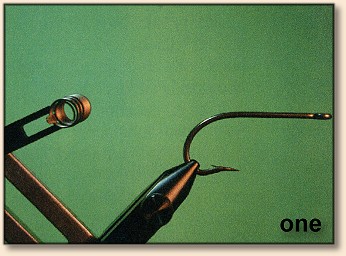
1. Secure the largest fly hook you can get your hands on.
I use saltwater hooks simply because of the large scale
they are made on. However, anything big, sharp and
strong will work.
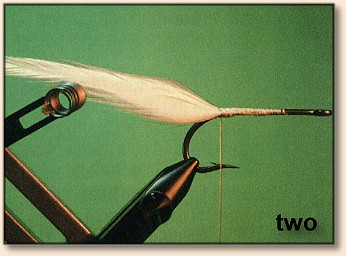
2. Start the thread near the middle of the hook shank.
Build a layer of thread, working towards the bend of the hook.
Tie in four to six white, webby saddle hackles at the tail,
so that they are concave (curving towards each other). It's
important that these saddles be as even and concave as
possible, as the tail will act as the "rudder" of the
fly. If there's too much "lean" in one direction, the
fly will spin when retrieved.
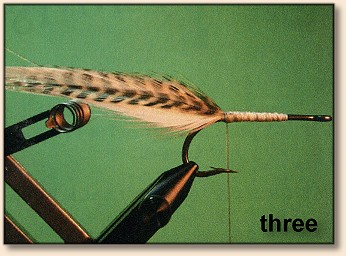
3. Tie in six to eight strands of pearl Krystal Flash to
the tail, trimming the ends to various lengths, some of
which should extend past the saddles. Add two grizzly
saddles (one on each side of the tail) tied in concave
to the white saddles.
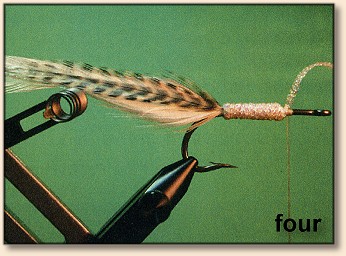
4. Attach an 8 inch strand of pearl mylar tubing, pearl
tinsel, or diamond braid to the base of the tail. Wrap the
thread forward along the shank, leaving about 1/3 of the
shank before the eye of the hook. Palmer the mylar tubing
forward creating the body of the fly in the process.
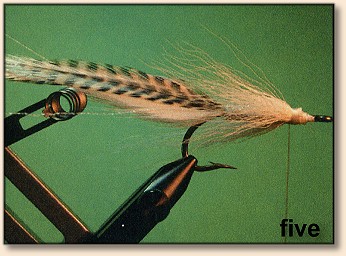
5. Prepare two clumps of long, white bucktail, each a
little smaller in diameter than a standard pencil. Tie in
one clump on each side of the fly, creating the collar, or
shoulders. Do not allow the bucktail to spin around the
shank.
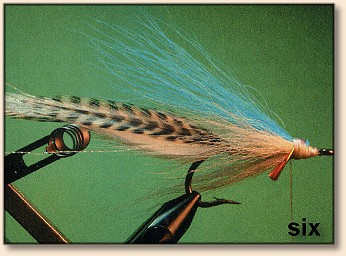
6. An optional variation is to add two more grizzly hackles
as a wing at this point. However, this is entirely up to
the tyer. Tie in an equal clump of blue bucktail on top
of the fly, then add short, red flashing material as the
throat on the bottom of the shank. Trim any excess. This
completes the throat and collar of the Deceiver.
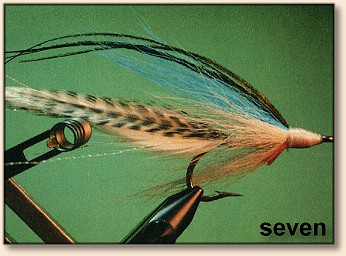
7. Tie in six to ten strands of long (five to six-inch) peacock
herl directly over the top of the blue bucktail on top of the
fly. The peacock herl will darken up the top of the fly and
gives supple movement to the pattern, contrasting nicely to
the more rigid bucktail.
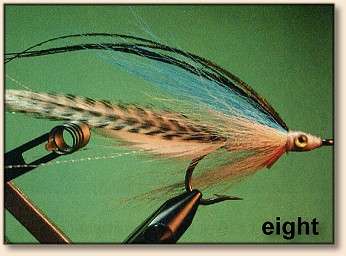
8. Use the 3/0 thread to create a pronounced head on the
remainder of the hook shank. Once the head of the fly is
complete, tie off the thread and apply prismatic 3D stick
on eyes. Finally, coat lightly with 5 minute epoxy and
let dry.
Credits: We thank the Canadian Fly Fisher for re-print permission!
Our Man In Canada Archives

